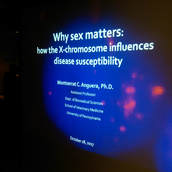|
Dr. Daniel Himmelstein (http://dhimmel.com/), a data scientist currently working out of the University of Pennsylvania's Greene Lab, shared his story about breaking down the "toll access" publication model, which prevents the public from accessing academic articles. Using computer and data science, Dr. Himmelstein showed how websites like Sci-Hub are already making primary science articles easier to access than ever before!
0 Comments
Insects have been around for almost 400 million years, live in habitats from pole to pole, and make up over half of all known species on earth. With all that time for evolution to work, and with all those varied situations to which they have adapted, it is no surprise that we can tap them for answers to questions as varied as how to make small flying robots, how to make an energy efficient television, or how to protect ourselves from bacterial infections. Dr. Fingerut gave us an enlightening talk about this fascinating group of organisms and showed us how our understanding of them has benefited both science and industry.
Advances in medical science now hold out the possibility of permanently correcting certain illnesses that are caused by defective genes. These are diseases like sickle cell disease, hemophilia (a bleeding disorder), cystic fibrosis, Parkinson's Disease and amyotrophic lateral sclerosis (Lou Gehrig's disease).
Dr. Tortella showed us how Gene Therapy is not something from "Star Trek" but actually the subject of current clinical trials on patients, i.e. "Star Trek, the Next Generation." Sleep is an essential behavior that we spend more than a third of our lives doing, however the function of sleep remains one of natures greatest biological mysteries. Every animal that has been observed closely has proven to display a sleep behavior of some form. Over the past few decades invertebrate animals like fruit flies and nematodes have provided insights into both the purpose and molecular regulation of sleep. Dr. Nelson gave us an exciting talk about the history and major contributions of the invertebrate sleep biology field.
We traveled with Dr. Eileen Grogan (Saint Joseph's University Department of Biology) and Dr. Richard Lund (Carnegie Museum of Natural History and SJU Research Associate) to go shark fishing in Montana, where bizarre sharks and other creatures of the 323 million year old marine Bear Gulch bay are captured in ancient rocks. We can't tell you where the Bear Gulch site it located (it's top secret!) but it contains a diverse amount of fossilized sharks and other related fishes. Some sharks fossil specimens resemble modern day eels and others demonstrate motherhood, paleozoic style. Sharks have really changed greatly over their evolutionary history!
|


























